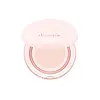What's inside
What's inside
 Key Ingredients
Key Ingredients

 Benefits
Benefits

 Concerns
Concerns

 Ingredients Side-by-side
Ingredients Side-by-side

Nylon-12
Magnesium/Potassium/Silicon/Fluoride/Hydroxide/Oxide
Polymethyl Methacrylate
Hdi/Trimethylol Hexyllactone Crosspolymer
Caprylyl Glycol
EmollientEthylhexylglycerin
Skin ConditioningSilica
AbrasiveIsopropyl Titanium Triisostearate
EmollientMyristic Acid
CleansingLauroyl Lysine
Skin ConditioningTocopherol
AntioxidantWater
Skin ConditioningButylene Glycol
Humectant1,2-Hexanediol
Skin ConditioningLimonia Acidissima Extract
Skin ConditioningGossypium Herbaceum Seed Extract
Skin ConditioningNylon-12, Magnesium/Potassium/Silicon/Fluoride/Hydroxide/Oxide, Polymethyl Methacrylate, Hdi/Trimethylol Hexyllactone Crosspolymer, Caprylyl Glycol, Ethylhexylglycerin, Silica, Isopropyl Titanium Triisostearate, Myristic Acid, Lauroyl Lysine, Tocopherol, Water, Butylene Glycol, 1,2-Hexanediol, Limonia Acidissima Extract, Gossypium Herbaceum Seed Extract
Water
Skin ConditioningDiphenylsiloxy Phenyl Trimethicone
Skin ConditioningButyloctyl Salicylate
Skin ConditioningPhenyl Trimethicone
Skin ConditioningAcrylates/Dimethicone Copolymer
Skin ConditioningHomosalate
Skin ConditioningEthylhexyl Salicylate
UV AbsorberTitanium Dioxide
Cosmetic ColorantStearic Acid
CleansingAlumina
AbrasiveCI 77891
Cosmetic ColorantAluminum Hydroxide
EmollientTriethoxycaprylylsilane
Zinc Oxide
Cosmetic ColorantGlycerin
HumectantCyclopentasiloxane
EmollientLauryl PEG-10 Tris(Trimethylsiloxy)Silylethyl Dimethicone
EmulsifyingTrimethylsiloxysilicate
EmollientNiacinamide
SmoothingCetyl PEG/PPG-10/1 Dimethicone
EmulsifyingPentaerythrityl Tetra-Di-T-Butyl Hydroxyhydrocinnamate
AntioxidantPolymethylsilsesquioxane
Dimethicone
EmollientIsododecane
EmollientAcrylates/Polytrimethylsiloxymethacrylate Copolymer
Skin ConditioningDisteardimonium Hectorite
StabilisingMagnesium Sulfate
CI 77163
Cosmetic ColorantSorbitan Sesquioleate
EmulsifyingCI 77492
Cosmetic ColorantButylene Glycol
HumectantCaprylic/Capric Triglyceride
MaskingPhosphatidylcholine
EmulsifyingGlycine
BufferingSerine
MaskingGlutamic Acid
HumectantAlanine
MaskingLysine
Skin ConditioningProline
Skin ConditioningThreonine
Arginine
MaskingGlyceryl Behenate/Eicosadioate
EmollientCaprylyl Glycol
EmollientParfum
MaskingEthylhexylglycerin
Skin ConditioningTocopherol
AntioxidantSilica Dimethyl Silylate
EmollientCI 77491
Cosmetic ColorantCI 77499
Cosmetic ColorantAdenosine
Skin ConditioningMica
Cosmetic ColorantRosa Damascena Flower Water
Masking1,2-Hexanediol
Skin ConditioningPrunus Persica Flower Extract
MoisturisingNelumbo Nucifera Flower Extract
Skin ConditioningPrunus Serrulata Flower Extract
Skin ConditioningPanthenol
Skin ConditioningSodium Hyaluronate
HumectantHydroxypropyltrimonium Hyaluronate
Sodium Acetylated Hyaluronate
HumectantHydrolyzed Hyaluronic Acid
HumectantHyaluronic Acid
HumectantPEG-Crosspolymer
Hydrolyzed Sodium Hyaluronate
Skin ConditioningPotassium Hyaluronate
Skin ConditioningCeramide NP
Skin ConditioningCI 77220
Cosmetic ColorantWater, Diphenylsiloxy Phenyl Trimethicone, Butyloctyl Salicylate, Phenyl Trimethicone, Acrylates/Dimethicone Copolymer, Homosalate, Ethylhexyl Salicylate, Titanium Dioxide, Stearic Acid, Alumina, CI 77891, Aluminum Hydroxide, Triethoxycaprylylsilane, Zinc Oxide, Glycerin, Cyclopentasiloxane, Lauryl PEG-10 Tris(Trimethylsiloxy)Silylethyl Dimethicone, Trimethylsiloxysilicate, Niacinamide, Cetyl PEG/PPG-10/1 Dimethicone, Pentaerythrityl Tetra-Di-T-Butyl Hydroxyhydrocinnamate, Polymethylsilsesquioxane, Dimethicone, Isododecane, Acrylates/Polytrimethylsiloxymethacrylate Copolymer, Disteardimonium Hectorite, Magnesium Sulfate, CI 77163, Sorbitan Sesquioleate, CI 77492, Butylene Glycol, Caprylic/Capric Triglyceride, Phosphatidylcholine, Glycine, Serine, Glutamic Acid, Alanine, Lysine, Proline, Threonine, Arginine, Glyceryl Behenate/Eicosadioate, Caprylyl Glycol, Parfum, Ethylhexylglycerin, Tocopherol, Silica Dimethyl Silylate, CI 77491, CI 77499, Adenosine, Mica, Rosa Damascena Flower Water, 1,2-Hexanediol, Prunus Persica Flower Extract, Nelumbo Nucifera Flower Extract, Prunus Serrulata Flower Extract, Panthenol, Sodium Hyaluronate, Hydroxypropyltrimonium Hyaluronate, Sodium Acetylated Hyaluronate, Hydrolyzed Hyaluronic Acid, Hyaluronic Acid, PEG-Crosspolymer, Hydrolyzed Sodium Hyaluronate, Potassium Hyaluronate, Ceramide NP, CI 77220
Ingredients Explained
These ingredients are found in both products.
Ingredients higher up in an ingredient list are typically present in a larger amount.
1,2-Hexanediol is a synthetic liquid and another multi-functional powerhouse.
It is a:
- Humectant, drawing moisture into the skin
- Emollient, helping to soften skin
- Solvent, dispersing and stabilizing formulas
- Preservative booster, enhancing the antimicrobial activity of other preservatives
Butylene Glycol (or BG) is used within cosmetic products for a few different reasons:
Overall, Butylene Glycol is a safe and well-rounded ingredient that works well with other ingredients.
Though this ingredient works well with most skin types, some people with sensitive skin may experience a reaction such as allergic rashes, closed comedones, or itchiness.
Learn more about Butylene GlycolCaprylyl Glycol is a humectant and emollient, meaning it attracts and preserves moisture.
It is a common ingredient in many products, especially those designed to hydrate skin. The primary benefits are retaining moisture, skin softening, and promoting a healthy skin barrier.
Though Caprylyl Glycol is an alcohol derived from fatty acids, it is not the kind that can dry out skin.
This ingredient is also used as a preservative to extend the life of products. It has slight antimicrobial properties.
Learn more about Caprylyl GlycolEthylhexylglycerin (we can't pronounce this either) is commonly used as a preservative and skin softener. It is derived from glyceryl.
You might see Ethylhexylglycerin often paired with other preservatives such as phenoxyethanol. Ethylhexylglycerin has been found to increase the effectiveness of these other preservatives.
Tocopherol (also known as Vitamin E) is a common antioxidant used to help protect the skin from free-radicals and strengthen the skin barrier. It's also fat soluble - this means our skin is great at absorbing it.
Vitamin E also helps keep your natural skin lipids healthy. Your lipid skin barrier naturally consists of lipids, ceramides, and fatty acids. Vitamin E offers extra protection for your skin’s lipid barrier, keeping your skin healthy and nourished.
Another benefit is a bit of UV protection. Vitamin E helps reduce the damage caused by UVB rays. (It should not replace your sunscreen). Combining it with Vitamin C can decrease sunburned cells and hyperpigmentation after UV exposure.
You might have noticed Vitamin E + C often paired together. This is because it is great at stabilizing Vitamin C. Using the two together helps increase the effectiveness of both ingredients.
There are often claims that Vitamin E can reduce/prevent scarring, but these claims haven't been confirmed by scientific research.
Learn more about TocopherolWater. It's the most common cosmetic ingredient of all. You'll usually see it at the top of ingredient lists, meaning that it makes up the largest part of the product.
So why is it so popular? Water most often acts as a solvent - this means that it helps dissolve other ingredients into the formulation.
You'll also recognize water as that liquid we all need to stay alive. If you see this, drink a glass of water. Stay hydrated!
Learn more about Water